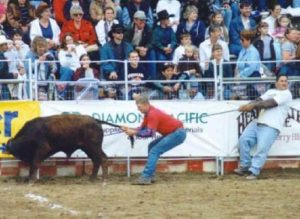 In the ever-evolving landscape of animal welfare, shelters face many challenges in their mission to find loving homes for their residents. While traditional outreach methods have their merits, they often fall short in reaching and engaging potential adopters effectively. In today’s digital age, the imperative for innovation becomes increasingly evident as shelters seek to revolutionize their outreach efforts. This article explores the critical role of innovative strategies in animal shelter outreach and marketing, providing insights and practical guidance to maximize impact and save lives. Continue reading “Innovative Outreach and Marketing Strategies for Animal Shelters on a Budget”
In the ever-evolving landscape of animal welfare, shelters face many challenges in their mission to find loving homes for their residents. While traditional outreach methods have their merits, they often fall short in reaching and engaging potential adopters effectively. In today’s digital age, the imperative for innovation becomes increasingly evident as shelters seek to revolutionize their outreach efforts. This article explores the critical role of innovative strategies in animal shelter outreach and marketing, providing insights and practical guidance to maximize impact and save lives. Continue reading “Innovative Outreach and Marketing Strategies for Animal Shelters on a Budget”
Something wicked this way comes: the rodeo by Ed Boks
Is the Rodeo coming to your town?
Rodeo animals are generally tame creatures who must be provoked into battle. 
They live lives filled with stress and fear.
Contestants practice their games on numerous calves, bulls, and horses, injuring and killing many animals before even entering the ring.
A contestant’s score is based on how long he can ride a struggling animal or how quickly he can overpower an animal.
Sprains, broken bones, muscle pulls, saddle blisters, spur wounds, flank strap wounds, punctured lungs, broken ribs, hematomas, bruising, and broken necks are common.
 Wounded animals are quickly removed while the rodeo announcer and rodeo clowns distract the public.
Wounded animals are quickly removed while the rodeo announcer and rodeo clowns distract the public.
The animals who become too injured to participate are sent to slaughter.
Domestic Violence Shelters must be pet-friendly by Ed Boks
A recent Washington Post article Little by little, domestic violence shelters become pet-friendly reports on a widening body of research regarding domestic violence. Over two decades of research has found that abusive partners often threaten, injure and even kill victims’ pets so as to persuade the victim not to leave.

In fact, surveys of women at shelters found that 20 to 50 percent say that fear for a pet’s safety delayed their decision to flee. “These situations are particularly dire when victims are deeply attached to their pets”, said Frank Ascione, a University of Denver psychologist who has published numerous studies on the topic.
“Particularly in households with no children”, Ascione said, “the pet or companion animal may be the only source of safe, affectionate contact that a woman has in her environment.” Continue reading “Domestic Violence Shelters must be pet-friendly by Ed Boks”
Its time to consider targeted pit bull spay/neuter programs by Ed Boks

Over the course of my career I may have been responsible for safely placing more pit bulls into loving homes than any other person in the United States.
I have long been troubled by the fact that no dog in history encounters more misunderstanding and vilification than the pit bull; a canine category I define as the American pit bull terrier, the American Staffordshire terrier, the Staffordshire bull terrier, and any crosses of these three. I admire these animals for their tenacious athletic ability, loyalty, intelligence, and high-energy.
Word reached me this morning that Henry Kleynhans, 50, a retired police officer was fatally mauled on February 8, 2018, and his wife Rita was critically injured, by their own pit bull in their home at Belmont Park, Kraaifontein, South Africa. Continue reading “Its time to consider targeted pit bull spay/neuter programs by Ed Boks”
Public comment sought for Bison Management in Grand Canyon National Park by Ed Boks
 In the 16th century North America contained 25-30 million buffalo. However, in the 19th century bison were hunted almost to extinction – with less than 100 remaining by the late 1880s. This mass destruction came with ease to hunters. When one bison is killed, the others gather around the fallen buffalo, which leads to the easy annihilation of large herds.
In the 16th century North America contained 25-30 million buffalo. However, in the 19th century bison were hunted almost to extinction – with less than 100 remaining by the late 1880s. This mass destruction came with ease to hunters. When one bison is killed, the others gather around the fallen buffalo, which leads to the easy annihilation of large herds.
As the great herds began to wane William F. “Buffalo Bill” Cody, among others, spoke in favor of protecting bison because he feared the pressure on the species was too great. In 1874, President Ulysses S. Grant “pocket vetoed” a Federal bill to protect dwindling bison herds. In 1875, General Philip Sheridan pleaded to a joint session of Congress to slaughter the herds to deprive the Indians of their source of food. By 1884, the American Bison was close to extinction.
In the effort to save this noble species a herd was brought to the Grand Canyon region in the early 1900s. The herd was managed from 1950 into the 1990s by the state of Arizona in the House Rock Wildlife Area (HRWA) in Kaibab National Forest.
During the late 1990s, the herd began migrating to the top of the Kaibab Plateau and into Grand Canyon National Park (GCNP). Today, few bison remain in HRWA preferring the environs of the Grand Canyon Park.
Some 400-600 bison live within the Park. The National Parks Service (NPS) contends the herd is impacting park resources, including water and vegetation – and they want to reduce the herd to 80-200 animals – using hunters.
Advocates for the use of lethal force include Senators John McCain and Jeff Flake, and Congressman Paul Gosar. Arizona Game & Fish Commission Chairman Kurt Davis says his agency won’t even consider a plan that doesn’t include killing, stating, “Any solution should embrace the most cost-effective and heritage-driven option of using citizen hunters to help manage the growing bison herd.”
“Cost-effective,” “heritage-driven” and “manage” is code for “bullets” “slaughter” and “kill” respectively.
Strangely, politicians seldom seem as concerned about the impact cattle have on our public lands. According to a 1997 EPA study, nearly one third of the prime top soil in the US has been lost over the last 200 years due to cattle grazing. Cattle are also considered one of the main sources of pollution in U.S. streams, and are frequently responsible for outbreaks of Giardia and Cryptosporidium.
In fact, bison grazing has been found to help cultivate the land, making it ripe for a diverse range of plants, whereas cattle eat through vegetation limiting the ecosystem’s ability to recover. Comparing cattle to bison is not meant to upset the cattle industry. But it does beg the question that with over 900,000 head of cattle impacting every corner of Arizona every day are we really willing to concede we don’t have the collective brainpower to humanely accommodate a few hundred bison without resorting to killing?
Congress has introduced a pair of bi-partisan bills meant to “protect” Park resources from further bison “damage” by “requiring” the Department of Interior and AZ Game and Fish to develop a plan to permit hunters to “assist in managing” the bison population.
The government’s approach to this “problem” brings to mind Maslow’s Golden Hammer (when all you have is a hammer every problem you encounter needs pounding).
Fortunately, there’s still time to propose humane, non-lethal solutions. NPS is granting the public until March 26 to weigh in. Perhaps, if enough of us ask state officials to consider life-affirming solutions we could begin to put our heritage-driven brutality behind us for good. Comments welcomed at https://parkplanning.nps.gov/commentForm.cfm?documentID=71123
Ed Boks is the executive director of the Yavapai Humane Society.
Legislators challenge Arizona’s moral progress By Ed Boks
Mahatma Gandhi said it best, “The greatness of a nation and its moral progress can be judged by the way its animals are treated.” The same can be said of the states in a nation.
In fact, the greatness and moral progress of all 50 states can be traced through the years by the consistent strengthening of state laws against animal cruelty to include felony provisions. This moral and legal progress has been based on the growing understanding of the link between animal cruelty and violence against humans.
Today, academic journals and textbooks in child welfare, human-animal studies, sociology, child development, criminology, psychology, social work, veterinary medicine, and many other disciplines accept the incontrovertible link between animal abuse, domestic violence, child maltreatment and elder abuse.
Understanding this link, the FBI now requires local law enforcement to track and report animal cruelty the same way homicide, arson and assault are tracked – as a Group A felony.
So, why would any Arizona legislator want to turn back the clock on progress that has taken decades to achieve? Why would any legislator want to strip any animal of any protection provided by the law?
Why would Arizona legislators David Gowan and Brenda Barton work behind closed doors with corporate agriculture lobbyists to craft a bill (HB 2330) designed to repeal the few protections millions of animals have in Arizona?
HB 2330 is not an isolated attempt to repeal Arizona’s animal cruelty laws. Last year enough Arizona legislators supported a similar bill (HB 2150) that it would have been the law of the land today except for Governor Ducey’s veto.
Fortunately, this year’s coup against animal welfare may have died in the Agriculture, Water and Lands Committee when they wisely chose to not agendize HB 2330.
However, the bill could still be resurrected by the House Appropriations Committee this year or introduced in another permutation next year. Animal advocates must remain vigilant in a state where politicians seem strangely determined to weaken animal-cruelty laws.
Apart from some Arizona legislators, animal abuse is widely recognized and understood by law enforcement, public health officials and decent human beings everywhere to be part of a continuum of violence with serious implications for multiple victims and society as a whole.
While Gandhi drew our attention to the societal ramifications of how we treat animals, Immanuel Kant provided some insight into how we should judge politicians who deliberately put animals in harm’s way. “He who is cruel to animals becomes hard also in his dealings with men. We can judge the heart of a man by his treatment of animals.” This maxim serves as a reliable gauge for assessing the character of politicians who have the power to impact how animals, and people, are treated on a massive scale.
Sponsors and supporters of last year’s HB 2150 and this year’s HB 2330 have telegraphed their agenda to reverse Arizona’s moral progress by revoking protections animals in Arizona have benefited from for decades. They have exposed their intent to put the welfare of millions of animals at risk without any corresponding benefit or legitimate justification. They need to know this is not going unnoticed.
Refer to my Feb. 17 column, “Lawmakers target animals again” to understand the risk of cruelty that HB 2330 posed for millions of animals.
Lawmakers target animals again By Ed Boks
Speaker of the House, Republican David Gowan, who is also running for Congress, is one of the prime sponsors of a bill raising serious concerns among people who understand the importance of strong prohibitions against animal cruelty.
House Bill 2330 will delight the corporate agriculture lobbyists who helped craft it to look like an animal protection bill – but in reality, this legislation is designed to repeal the few protections millions of animals have in Arizona.
HB 2330 is nearly identical to the first bill Gov. Doug Ducey vetoed after taking office last year. Again animal-welfare advocates are asking state representatives to defeat a bill intent on weakening the state’s current animal-cruelty laws.
The bill would remove livestock and poultry from Arizona’s definition of animals in the criminal code – stripping them of any protection from anti-cruelty laws. Further, the bill omits the crime of “abandonment” and the requirement to provide medical care to farm animals – both of which are crimes under current law. Under HB 2330, a person could abandon his horse in the desert and leave it to die without penalty.
HB 2330 would also forbid any city, town or county from enacting laws tougher than this watered-down bill. For example, in 1996, the City of Phoenix enacted an ordinance banning home slaughter of livestock following an investigation of people slaughtering goats in apartment complexes. Under HB 2330, local governments will be powerless to address issues like this in their communities.
One bizarre requirement of HB 2330 is that the Department of Agriculture Director has to be notified of any investigation of livestock abuse. The bill actually requires police officers investigating livestock abuse to notify civilians in the Department of Agriculture, thereby compromising ongoing criminal investigations. No other area of law enforcement requires such an outside notification.
HB 2330 not only threatens sensitive animal cruelty investigations conducted by law enforcement, it literally puts the fox in charge of the hen house.
HB 2330 revokes protections that all animals in Arizona have benefited from for decades and puts the welfare of certain animals at substantial risk – without any corresponding benefit or legitimate justification.
Watching the Department of Agriculture trying to undermine existing animal-cruelty statutes begs the question, “What are they trying to hide?” If most farmers and agricultural people treat their animals well, as I am convinced they do, why do they need to be exempt from animal-cruelty statutes?
The Yavapai Humane Society shares the concern of many lawmakers that animal welfare groups were not invited to be involved in the drafting of this bill nor were they even allowed to participate in any stakeholder meetings.
In a letter announcing his veto of a similar bill last year, Ducey explained, “we all agree animal cruelty is inexcusable and absolutely will not be tolerated in the state of Arizona. No animal should be the victim of abuse. Moreover, perpetrators must be held to account and properly penalized to the fullest extent of the law.
“We must ensure that all animals are protected, and [be] mindful that increasing protections for one class of animals does not inadvertently undercut protections of another,” which is exactly what HB 2330 intentionally does.
HB 2330 is bad law. We can do better. Let your state representatives know how you feel.
State sanctions county, municipal feral cat programs by Ed Boks
 The Yavapai Humane Society (YHS) does not accept feral cats. Taking unadoptable feral cats into an animal shelter is a death sentence and is contrary to the YHS no-kill ethic. Rather than employing the “catch and kill” methodology used by many shelters, YHS champions trap/neuter/return (TNR) as the only viable and humane method for effectively reducing feral cat populations.
The Yavapai Humane Society (YHS) does not accept feral cats. Taking unadoptable feral cats into an animal shelter is a death sentence and is contrary to the YHS no-kill ethic. Rather than employing the “catch and kill” methodology used by many shelters, YHS champions trap/neuter/return (TNR) as the only viable and humane method for effectively reducing feral cat populations.
The Arizona state legislature recently came out in strong agreement with YHS on TNR. Arizona’s governing body overwhelmingly passed SB1260. The new law encourages animal control to return healthy “stray” cats to the vicinity where they were captured after being sterilized; the very definition of TNR.
Coincidentally, perhaps the strongest scientific support for Arizona’s robust endorsement of TNR comes from a 13-month study conducted by the Tasmanian Department of Primary Industries in Hobart, Australia. The study, entitled “Effects of low-level culling of feral cats in open populations” appeared in a recent edition of the journal Wildlife Research, 2015. The findings, trumpeted by the Australian Broadcasting Corporation, Discovery Science, and other media, directly contradict the Australian government, and its environment minister Greg Hunt, who has called for the “effective” eradication of all feral cats by 2023.
Biologist Billie Lazenby, who led the study, says she expected to validate the use of lethal culling (catch and kill) promoted by the Australian government but instead found, to her dismay, that culling markedly increases the numbers of feral cats in an area.
Lazenby and her team of researchers used remote trail cameras to estimate the number of feral cats at two southern Tasmania study sites before and after a 13-month “low-level culling.”
However, Vox Felina blogger Peter Wolf observed, “The effort was anything but low-level. Over the course of 13 months, researchers managed 2,764 trap-nights-an average of seven traps every day of the culling period. Each trapped cat was, after being left in the trap for up to 12 hours or more, ‘euthanized by a single shot to the head from a 0.22 rifle using hollow point ammunition.'”
“Contrary to our prior expectations,” reported Lazenby, the “number of feral cats rose 75 percent at one test site and 211 percent at the other.” Of particular interest, “Cat numbers fell, and were comparable with those in the pre-culling period, when culling ceased.” Suggesting feral cats fill a stable self-regulated ecological niche.
The researchers ultimately concluded the surprising population explosion was the result of “influxes of new [adult] individuals after dominant resident cats were removed.” A phenomenon YHS refers to as the “vacuum effect.” When cats are removed but natural conditions (such as food sources) remain the deterrents of existing territorial cats vanish and neighboring cats quickly invade and overpopulate the newly open territory.
When culling feral cats, Lazenby now says “You may be inadvertently doing more damage than good.”
“What we should focus on when managing feral cats is reducing their impact; and you don’t reduce impact by reducing numbers.” In fact, a growing number of studies conclusively prove lethal culling induces a biological imperative that causes feral cats to overbreed and overproduce to survive. Counter-intuitively, lethal culling directly exacerbates feral cat problems.
Gratefully Arizona has a legislature who understands the science and through SB1260 is directing county and municipal animal control agencies to recognize TNR as the only viable, humane solution to our communities’ vexing feral cat problems.
Arizona is leading the nation through this ground breaking legislation. How wonderful would it be if Yavapai County and local municipalities took the lead by building an effective and humane trap/neuter/return program on this historic foundation?
Animal abuser registries would protect all of us By Ed Boks
Sex offender registration is a system designed to allow authorities to track the residence and activities of sex offenders. Information in the registry is made available to the public via a website or other means. In many jurisdictions registered sex offenders are subject to restrictions including housing, being in the presence of minors, and living in proximity to a school or day care center.
Efforts are now underway to expand this concept to include animal abusers. Initiatives are gaining support and legislation has been introduced in at least five states, including Arizona.
The Arizona Animal Cruelty Registry Law (HB 2310) would require people convicted of animal torture, mutilation, intentional killings and animal fighting to register with the police and provide an array of personal information along with a current photograph, much like sexual predators. The information, along with the registrants’ specific offense, would be posted on the Internet.
Animal welfare activists hope laws like this will inspire governments nationwide in the same way Megan’s Law registries for child molesters have proliferated in the past decade.
In Florida, State Senator Mike Fasano proposed Dexter’s law, named after a kitten beaten to death in his state. His proposal would require convicted animal abusers to register with authorities. Their names, home addresses and photographs would be posted online, and they would pay $50 a year to maintain the registry.
Registries have also been proposed in Colorado, Maryland and New York and similar proposals are expected in other states.
Suffolk County on Long Island moved to create a registry in 2010, and has since been followed by two other New York counties. No names appear on the Suffolk County registry yet, because it was only recently set up. Convicted abusers will appear on the registry for five years. Those failing to register are subject to a $1,000 fine and up to a year in jail.
The New York counties require pet stores and animal shelters to check the names of anyone seeking to adopt or buy an animal against the registry.
Maryland State Senator Ronald Young said he plans to introduce legislation in the wake of two incidents in his state. In one, a Yorkshire terrier was thrown off a 23-foot-high balcony; the dog, Louie, survived. In the other, a golden retriever puppy named Heidi was shot to death.
A bill to create a registry in California, introduced in 2010, didn’t make it through the Legislature, partly because of concerns about its cost.
Liberty Watch Colorado, an advocacy organization committed to holding elected officials accountable, says such legislation is “an unnecessary expansion of government.’
However, the Animal Legal Defense Fund, an animal rights law organization based in California, outlines some taxpayer benefits. For instance, well-managed registries can reduce the number of abused animals and the animal control costs associated with caring for and treating abused animals. They also serve as an early warning system for potentially violent criminals like Ted Bundy, David Berkowitz and Jeffrey Dahmer all of whom tortured and killed animals during their childhoods.
“Researchers as well as FBI and other law enforcement agencies nationwide have linked animal cruelty to domestic violence, child abuse, serial killings and the recent rash of killings by school age children,” says Dr. Randall Lockwood, vice president of training for the Humane Society of the United States.
Albert Schweitzer said it best when he warned that “Anyone who has accustomed himself to regard the life of any living creature as worthless is in danger of arriving also at the idea of worthless human lives.” Registering felony animal abusers not only helps protect innocent animals, it helps protect our families, friends and neighborhoods.
Nathan Winograd’s deceptive attacks obfuscate facts by Ed Boks

Recently Nathan Winograd mischaracterized a portion of an email from me as suggesting LA’s spay/neuter law is a failure. This is typical of the divisive sniping endemic in all of Nathan’s self-aggrandizing philosophy.
The email quotes a portion of an email that says, “we can’t hide from the fact that veterinarians are raising their prices to a point where people cannot afford the services regardless of vouchers or financial assistance. We need some innovative thinking in addition to more mobile vans.” Continue reading “Nathan Winograd’s deceptive attacks obfuscate facts by Ed Boks”
